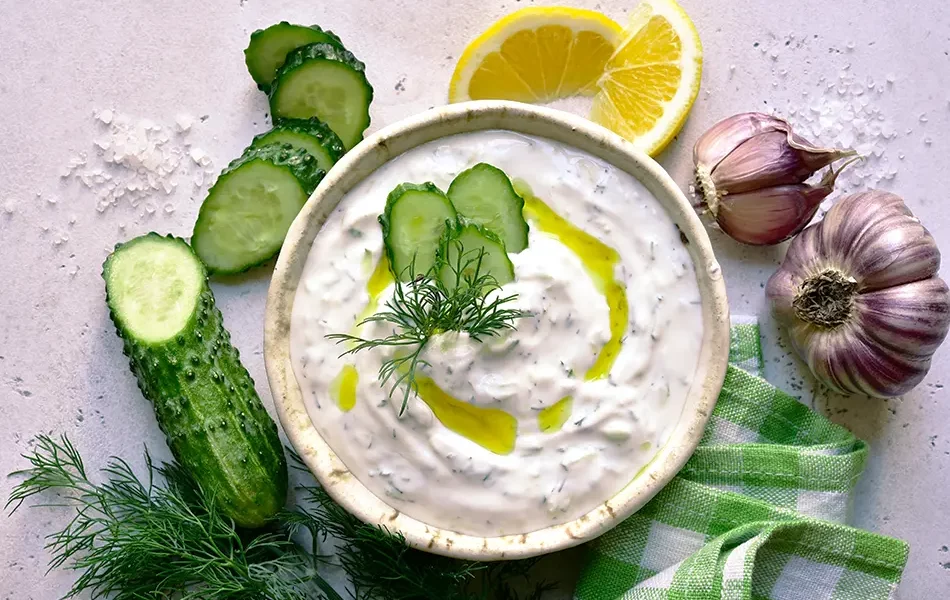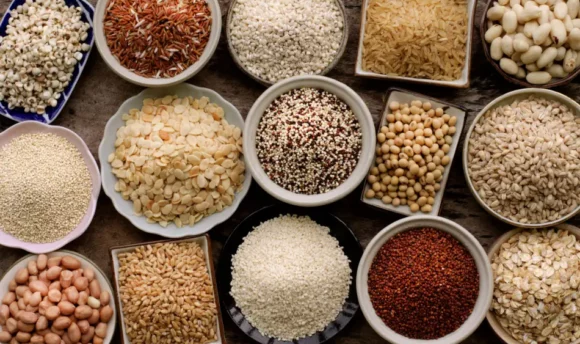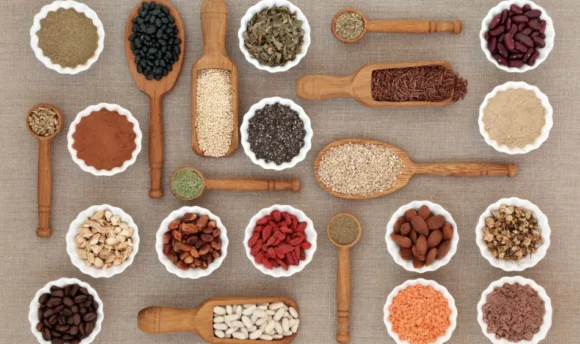Is Tzatziki Healthy? Exploring the Nutritional Profile
Discover the health benefits and potential drawbacks of this classic Greek dip.

Tzatziki is a popular dip from Greek cuisine characterized by its acidity and crunchy texture from fresh cucumbers.
The combination between yogurt and cucumbers brings a wealth of health benefits to the table with a special tangy taste that makes it a versatile accompaniment to a wide range of dishes.
If you are passionate about healthy food and are always looking for different ideas for your menu, this international dip is worth trying. We invite you to learn about all the nutrients it has to offer. Stay here to find out!
Is Tzatziki Healthy?
Yes, eating tzatziki is good for your health because it is generally low in calories and fat, especially when made with a yogurt low in fats. It often contains fresh herbs like dill or mint, which add flavor and contribute antioxidants and potential anti-inflammatory properties.
However, it’s important to note that the overall healthiness of tzatziki can vary based on the specific recipe and preparation methods. Some versions may contain added oils or higher amounts of salt, which can impact their nutritional profile.
What Is Tzatziki?
Tzatziki is a dip typically made with a base of strained Greek yogurt and grated cucumber with herbs like dill or mint to enhance the flavor. It is often used as a dip for fresh vegetables and is paired with pita bread or whole-grain crackers.
It is a healthy Greek food that can be enjoyed as a sauce or a spread, depending on personal preferences. Traditionally, tzatziki is served alongside grilled meats like chicken, lamb, kebabs, or as a healthier alternative to traditional salad dressings.
Tzatziki ingredients
The basic recipe for tzatziki contains the following ingredients:
- Yogurt: Making tzatziki with good yogurt from cow’s milk or goat’s milk is essential for a nutrient-rich, delicious result. Tzatziki is traditionally made with strained yogurt (or Greek yogurt).
- Cucumber: Cucumber is a vital component of tzatziki, adding a refreshing and crisp element. It is grated or finely diced and often strained to remove excess moisture.
- Garlic: This is a key flavor enhancer in tzatziki, providing a special touch that diminishes the strong taste of yogurt. It is finely minced or crushed to release its aromatic compounds.
- Olive oil: Extra virgin olive oil is usually added to tzatziki and other dressings to give it a smooth taste.
- Herbs and spices: Fresh herbs like dill or mint are commonly used in tzatziki, imparting their unique flavors. Some recipes may also include additional herbs like parsley or cilantro for added freshness.
- Lemon: The juice of lemon adds a subtle tanginess to the tzatziki, complementing the creamy yogurt and refreshing cucumber.
Tzatziki Nutrition
This dressing is arguably one of the healthiest because it contains a protein base of yogurt which gives it a very healthy nutritional profile.

How many calories are in tzatziki?
Tzatziki typically contains around 93 calories per 100 grams, which makes it low in calories.
Calories may vary slightly depending on the specific recipe and ingredients used. Tzatziki’s calorie count is primarily influenced by the yogurt and oil, which provide fat and protein.
Health Benefits of Tzatziki
It is possible to indulge in a refreshing dressing and eat it with the assurance that you are filling your body with essential nutrients. Discover some of the benefits of eating tzatziki:
#1 Source of healthy fats
Tzatziki can be considered a source of healthy fats due to the presence of plain yogurt and, in some cases, olive oil. Yogurt contains naturally occurring fats, including saturated fats and unsaturated fats.
Unsaturated fats, such as monounsaturated and polyunsaturated fats, are considered healthier fats. These fats can have positive effects on heart health by helping to lower LDL (bad) cholesterol levels when consumed in moderation.
#2 Nutrient-rich ingredients
Tzatziki is considered nutrient-rich because it contains ingredients that provide valuable nutrients for your body.
From the protein in the yogurt, the vitamin C in lemon, and the antioxidants in the herbs, eating tzatziki provides great benefits for your skin, stomach, and overall health.
#3 Probiotic boost
The yogurt used in tzatziki dip often contains naturally occurring live active cultures or probiotics. Probiotics are beneficial bacteria that support gut health and contribute to a healthy digestive system.
Probiotics reach the intestines and interact with the gut microbiota, promoting a healthy balance of good and bad bacteria in the digestive system. This can help improve digestion, enhance nutrient absorption, support immune function, and contribute to overall gut health.
#4 Rich in calcium
Calcium in tzatziki dressing primarily comes from the yogurt used as the base ingredient. Yogurt is known for its calcium content, with the exact amount depending on the specific brand and type of yogurt used.
Calcium levels in tzatziki can range from around 65 milligrams per 100 grams, depending on factors such as the type of milk used (whole or non-fat) and the yogurt’s processing methods. Greek yogurt, which is commonly used in tzatziki, tends to have a higher concentration of calcium compared to regular yogurt.
Downsides of Tzatziki
While tzatziki can be a nutritious addition to your diet, there are a few potential considerations to always keep in mind:
#1 High in sodium
Depending on the amount of added salt, tzatziki can have varying levels of sodium. Excessive sodium intake can contribute to high blood pressure and increase the risk of cardiovascular issues.
#2 Might be high in calories
Tzatziki contains olive oil and yogurt, key ingredients in the recipe that are healthy but calorie dense because they are a source of healthy fats. If you are in the process of weight loss, it is important to know that every gram of fat provides 9 calories.
#3 Have allergens
The secret of a good thick and creamy tzatziki is Greek yogurt, which contains less lactose thanks to its preparation process. However, people who are lactose intolerant or sensitive to lactose may suffer allergic reactions.
It’s important to be aware of any personal dietary restrictions or sensitivities and choose alternative options such as coconut yogurt or almond milk yogurt.
Best Healthy Tzatziki Recipe
The key to making tzatziki is to choose high-quality, organic, and fresh ingredients. That way, you make sure you get all the nutrients. Check out this delicious and easy recipe:
Ingredients:
- 1 cup Greek yogurt, low in fat
- 1 cucumber, peeled and grated
- 2 cloves of garlic, minced
- 1 tablespoon fresh lemon juice
- 1 tablespoon extra-virgin olive oil
- 1 tablespoon chopped fresh mint
- Salt to taste
- Pepper to taste
Instructions:
- Peel and grate cucumber. Squeeze out excess moisture.
- In a bowl, combine the low-fat Greek yogurt, grated cucumber, minced garlic, lemon juice, and olive oil.
- Stir in the chopped fresh mint and season with salt and pepper to taste.
- Mix all the ingredients well.
- Taste the tzatziki and adjust the seasoning according to your preference.
- Refrigerate for at least 1 hour to allow the flavors to meld together.
- Serve chilled as a dip with fresh vegetables, pita bread, or as a sauce.
FAQs
Yes, it is a good choice for weight loss since it contains 93 calories in 100 grams, and a spreadable portion is two tablespoons (30g), which provides only 28 calories.
Yes, because the base of tzatziki is yogurt which provides protein, and the base of full-fat mayonnaise is oil which provides fats that are usually unhealthy.
Yes, the combination of yogurt and cucumber in tzatziki can help soothe and calm the digestive system thanks to the probiotics and vitamins in it.
A Word From a Nutritionist
Tzatziki is an excellent choice to accompany main meals such as meat and poultry, as well as snacks when spread on toasted bread and grilled vegetables.
The classic recipe is already healthy and delicious, and it is so versatile that you can adapt it to your taste by adding other vegetables and herbs.
An excellent idea is to use it also as a salad dressing, even though it is not as liquid as typical dressings, its creamy consistency will enhance the flavor of your fresh greens and will add a special touch thanks to its spice blend.
This way, you avoid high-fat dressings and commercial mayonnaise, significantly reducing calories and increasing nutrients.
Conclusion
Tzatziki is a healthy and nutritious food. It offers a nutritious combination of fresh ingredients that provides protein, calcium, probiotics, hydration, and essential vitamins and minerals.
Due to its low-calorie content, eating tzatziki can be a healthier alternative to other dips and spreads, offering a satisfying and flavorful addition to meals or snacks.
The potential health benefits of tzatziki include improved digestion, weight loss, support for gut health, and the incorporation of healthy fats from olive oil.

















































 Select your language:
Select your language: 








